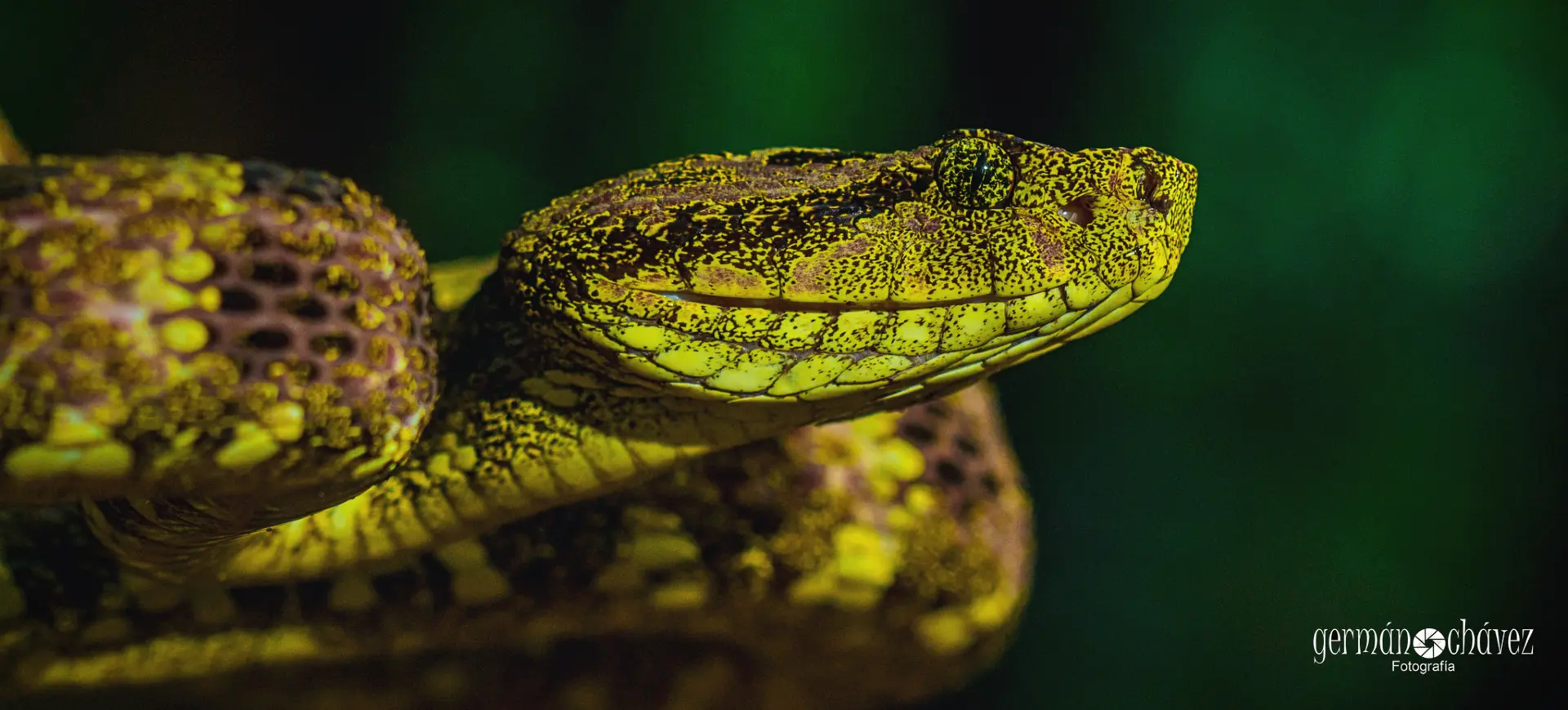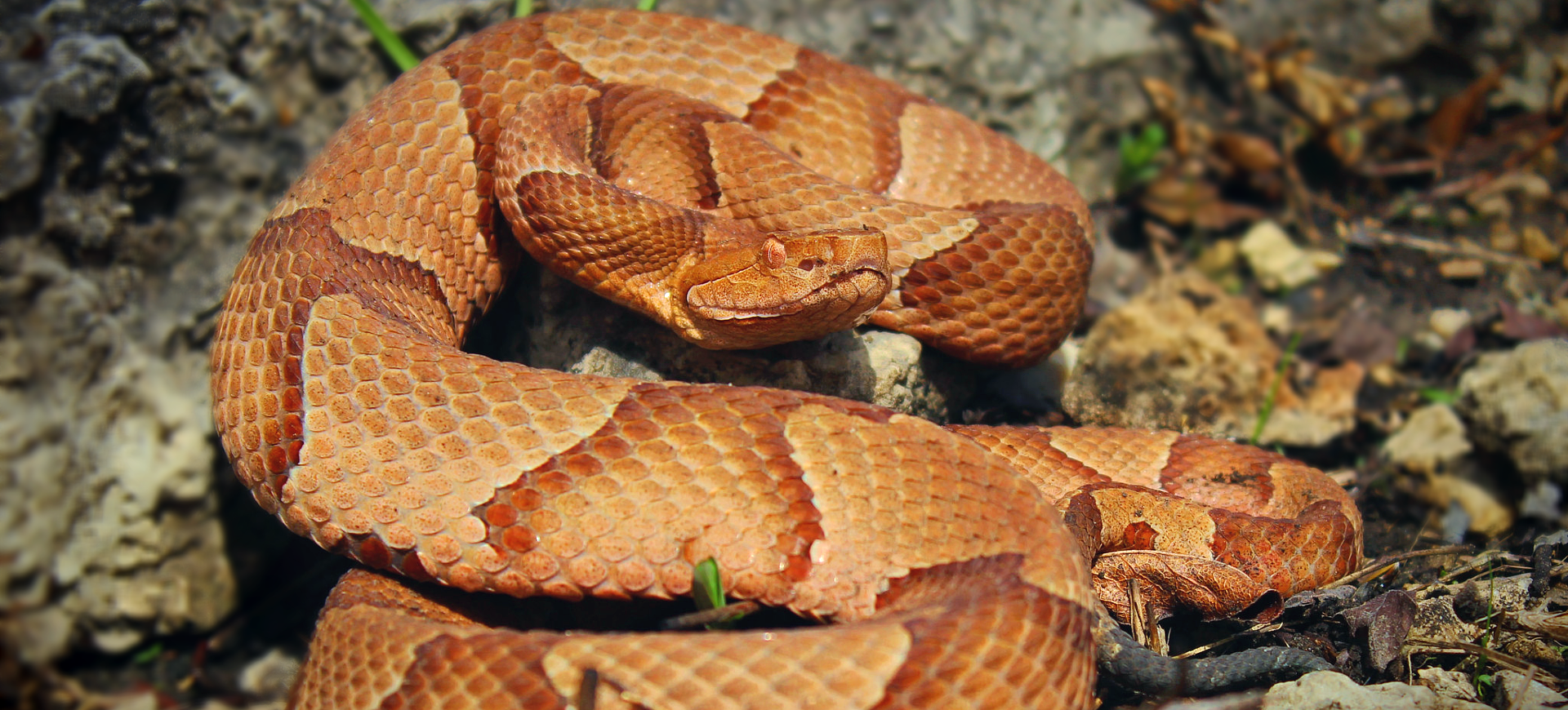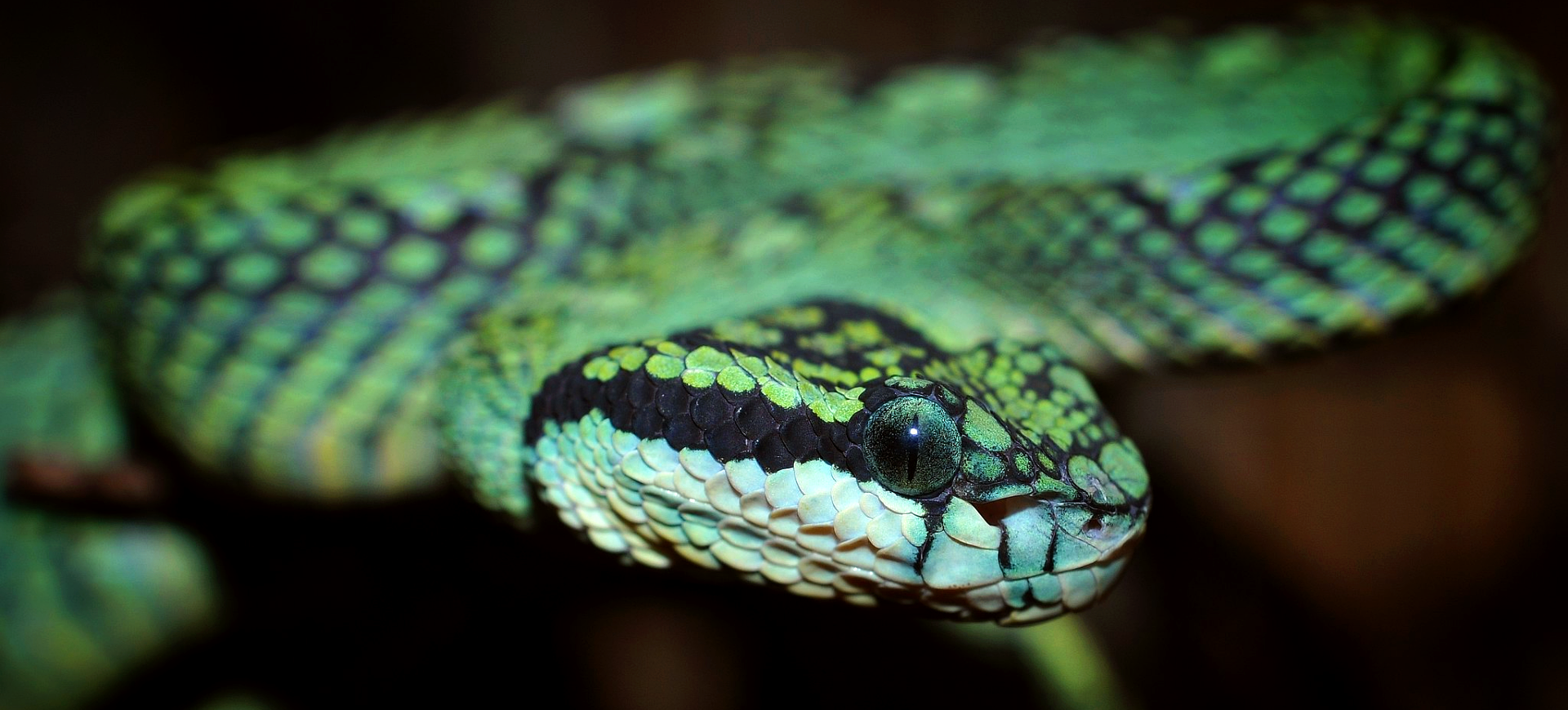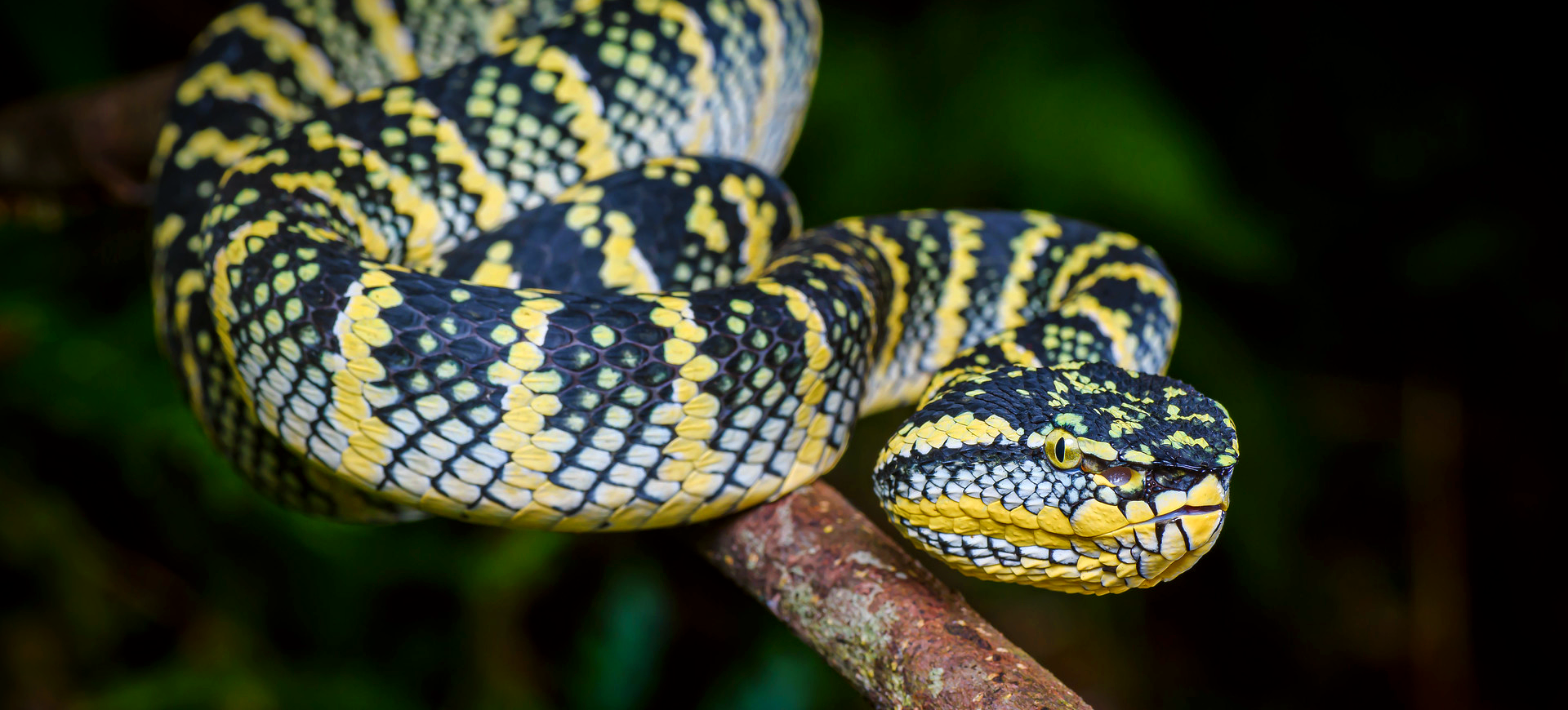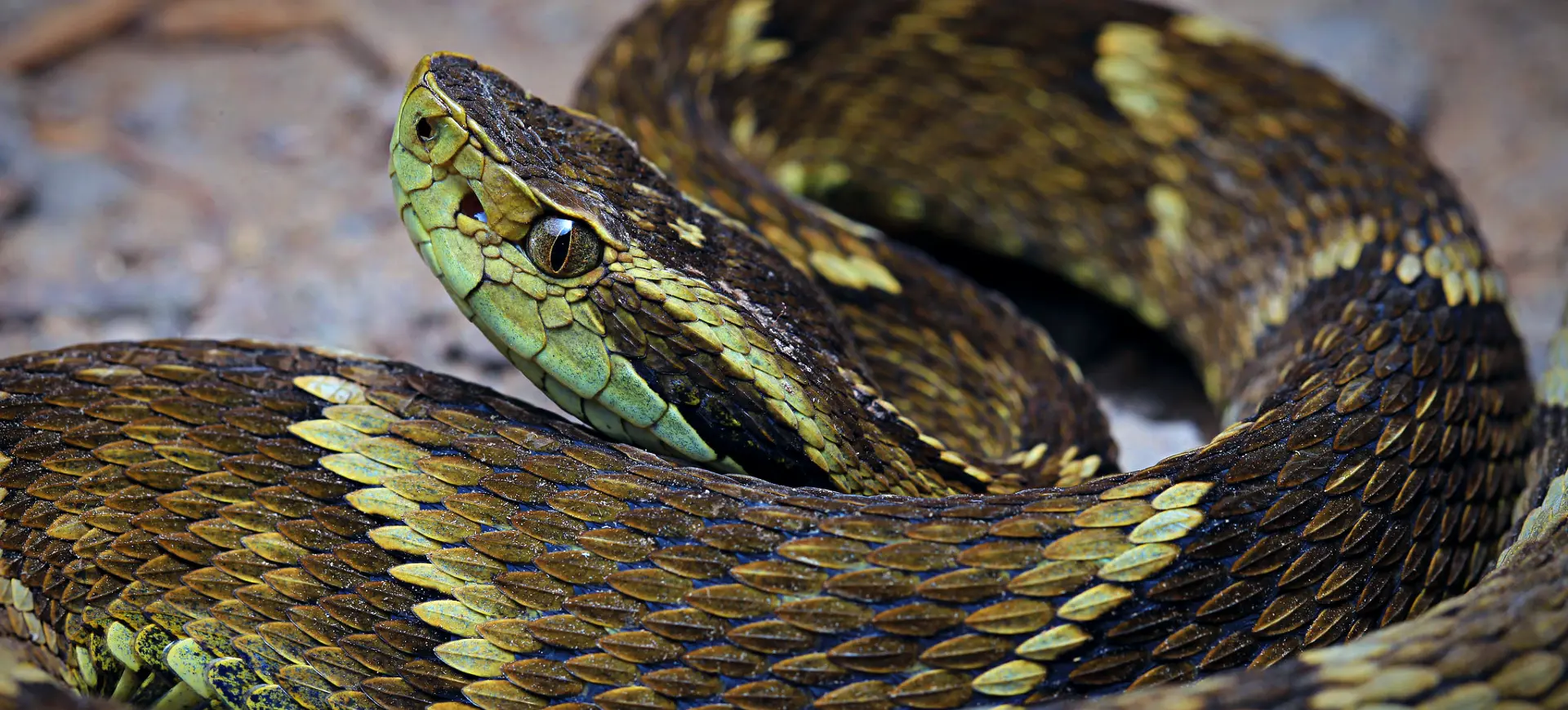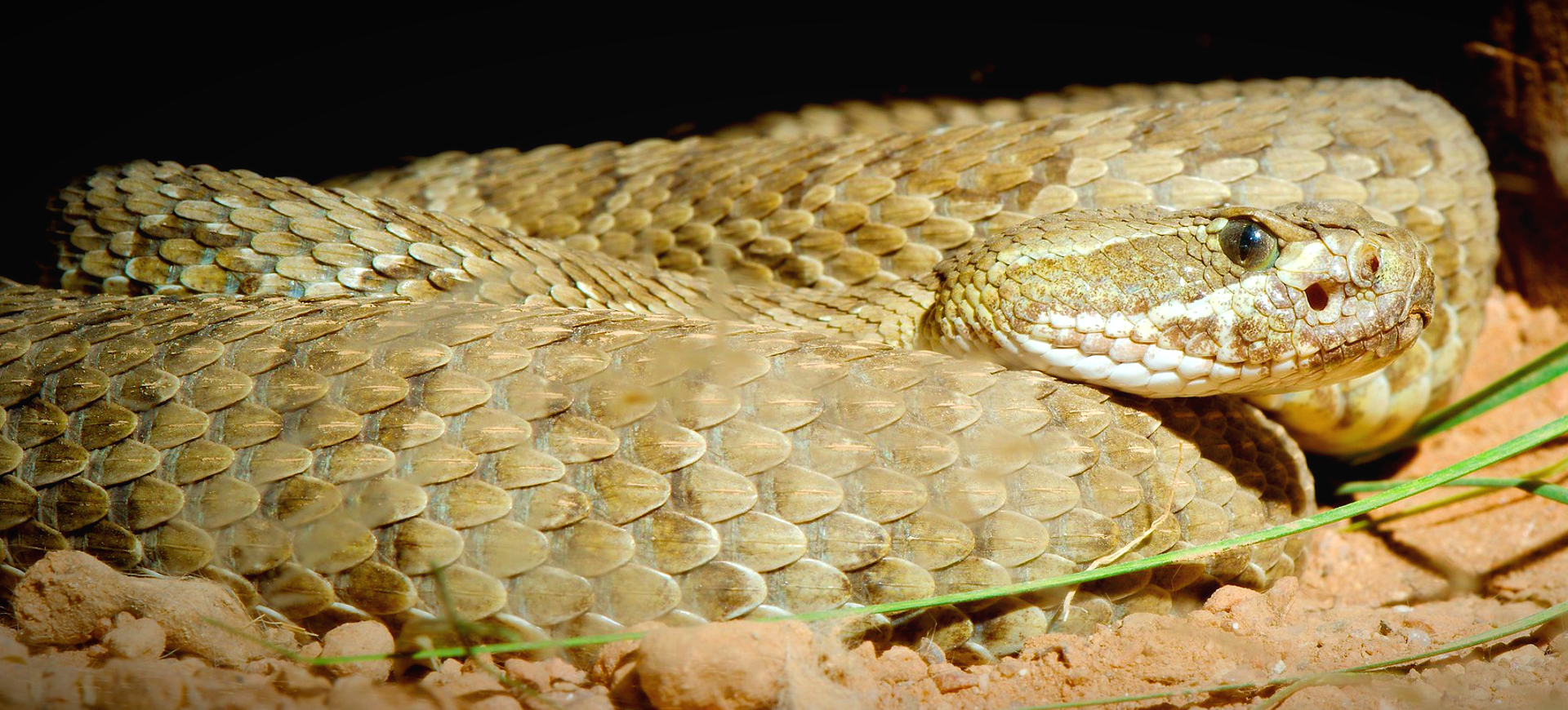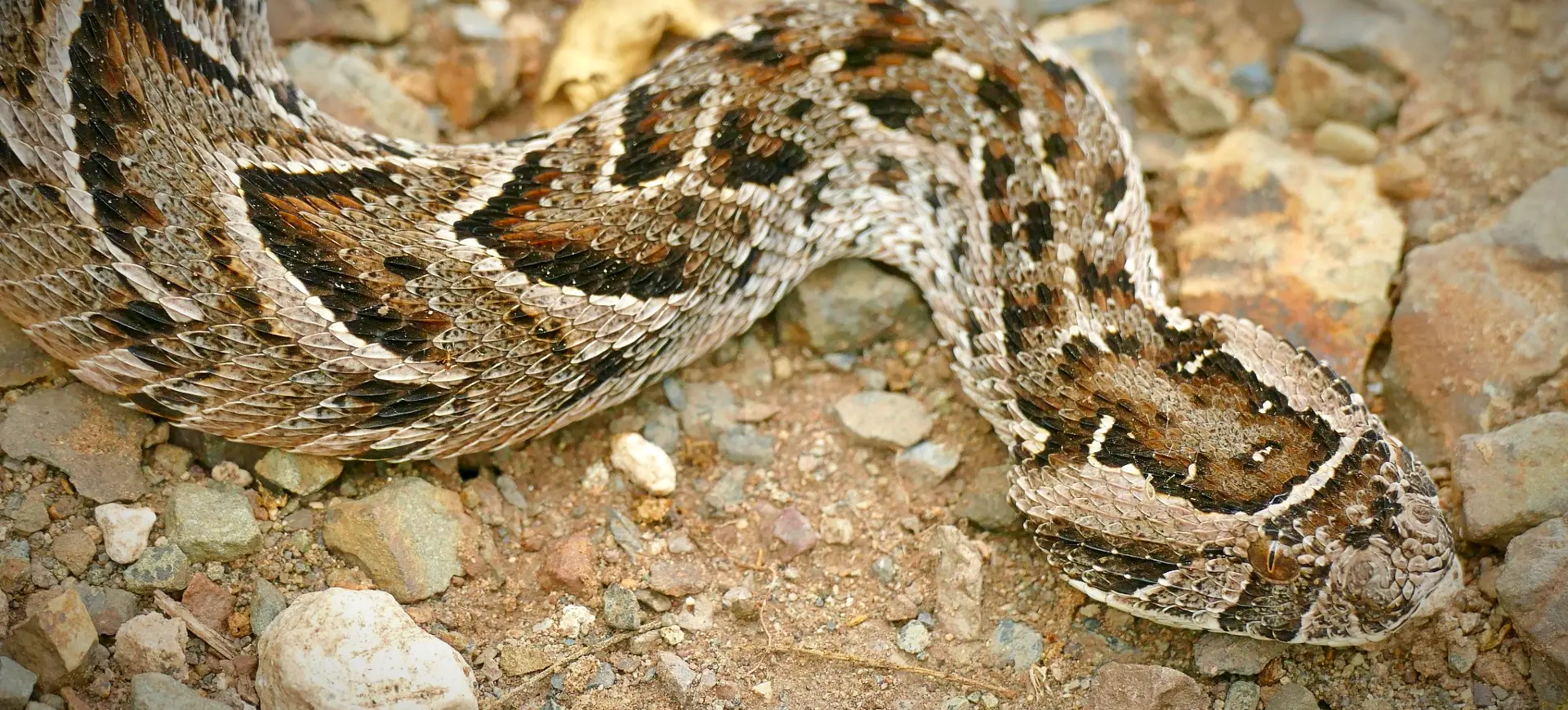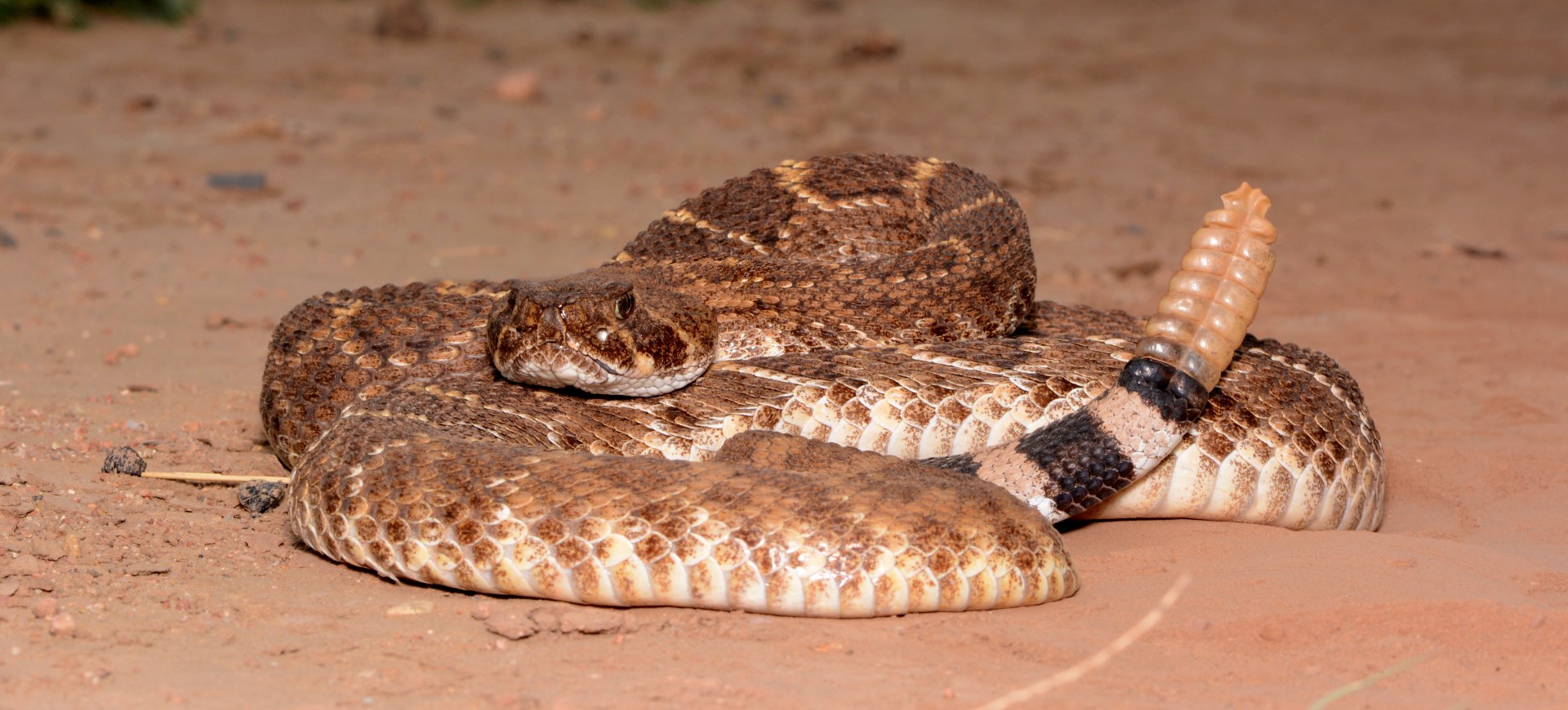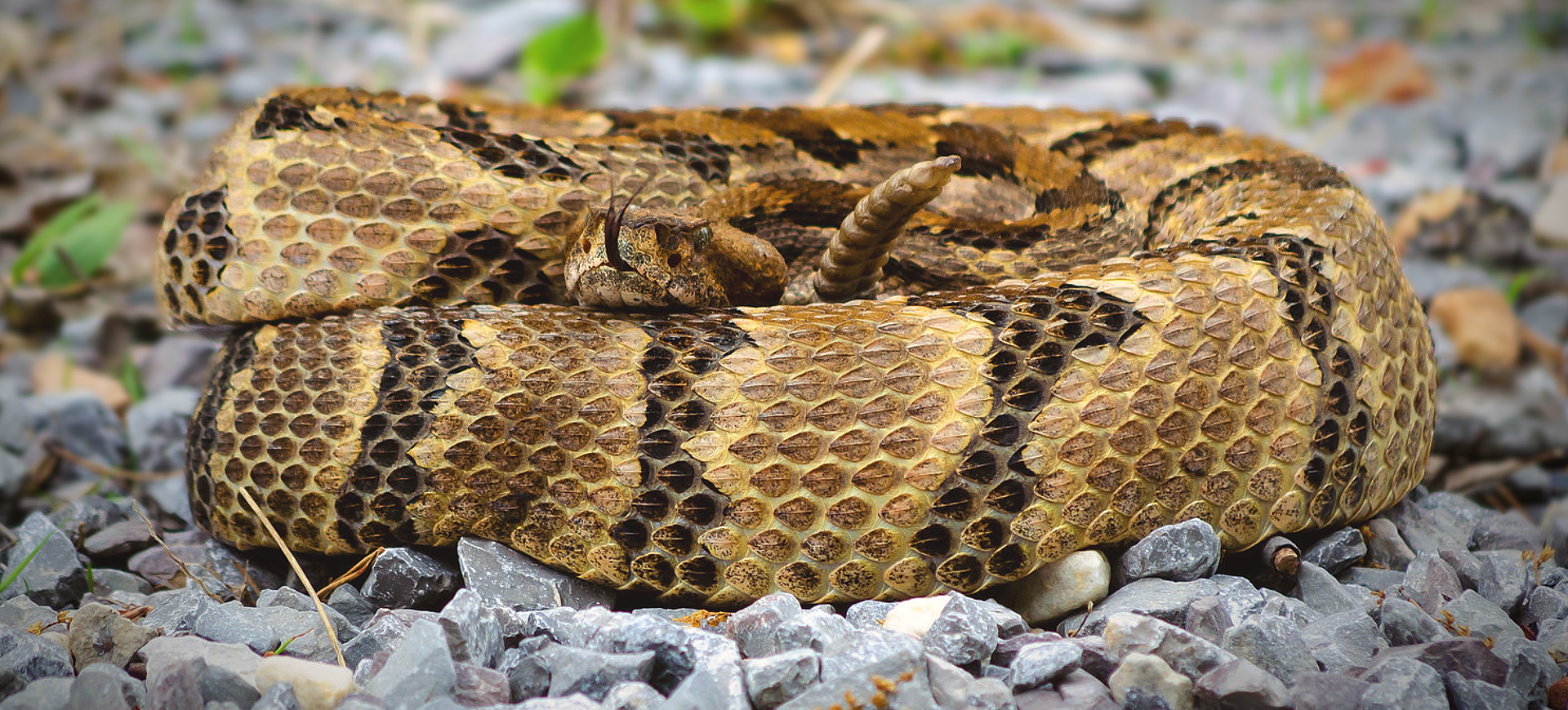Overview
The West African Gaboon Viper, Bitis rhinoceros, is renowned for its distinctive appearance and size. It has a broad, triangular head, a thick body, and a relatively short tail, all contributing to its unique, formidable look. This snake’s most striking feature is its intricate and colorful pattern, designed to provide exceptional camouflage in its natural forest floor habitat. The Gaboon Viper is known for its extremely long fangs, the longest of any venomous snake, and a potent venom that makes it a respected and cautious encounter in the wild.
The West African Gaboon Viper is generally a sedentary species, preferring to lie in wait for its prey rather than actively hunting. It feeds primarily on small mammals and birds, using its well-camouflaged body to ambush unsuspecting animals. Despite its fearsome reputation, this viper is typically calm and reluctant to bite unless provoked. It is a nocturnal creature, becoming more active at night when it moves to different locations or hunts.
Conservation efforts are increasingly important for the West African Gaboon Viper as it faces habitat loss and degradation in its natural range. The snake’s specific habitat requirements make it vulnerable to the effects of deforestation and human encroachment. While it is not currently considered critically endangered, the ongoing loss of habitat and potential for over-collection for the pet trade poses significant threats to its populations. Education and habitat conservation are crucial for ensuring the future of this remarkable species.
Physical Description:
The West African Gaboon Viper is noted for its substantial body size and can grow to lengths of 4 to 6 feet, making it one of the largest vipers in Africa. Its thick and heavy body contributes to a somewhat sluggish appearance, but this bulk makes it such a powerful predator. The snake’s coloration is an intricate combination of browns, tans, blacks, and pinks, forming a complex pattern that mimics the forest floor, aiding in its camouflage. The head is broad and triangular, with two horn-like structures on its nose, giving it a distinct and recognizable appearance.
This snake’s skin has a velvety texture, and its body scales are keeled, adding to the complexity of its camouflage. The eyes are small with vertical pupils, characteristic of nocturnal snakes. Its fangs can be up to 2 inches long, the longest of any venomous snake, allowing it to deliver a large volume of venom deep into its prey. Despite its intimidating size and appearance, the Gaboon Viper is known for being relatively docile when not threatened.

Lifespan: Wild: ~18 Years || Captivity: ~20 Years

Weight: Male: 12-18 lbs (5.4-8.2 kg) || Female: 18-25 lbs (8.2-11.3 kg)

Length: Male: 48-60 inches (122-152 cm) || Female: 60-72 inches (152-183 cm)

Top Speed: Less than 1 mph (<1.6 km/h)
Characteristic:
Native Habitat:
The West African Gaboon Viper inhabits the rainforests of West Africa, thriving in dense, moist environments where the forest floor provides ample cover and hunting grounds. Its range extends through several countries, including Ghana, Guinea, Liberia, and Sierra Leone. This snake prefers the leaf litter and fallen branches of the forest floor, where its camouflage allows it to blend almost seamlessly into its surroundings. The humidity and temperature of the rainforest provide the ideal conditions for this species.
It’s not uncommon for Gaboon Vipers to remain in one location for extended periods, waiting for prey to come within striking distance. This passive nature means their habitat needs to be rich in prey and provide sufficient cover for effective ambush hunting. The rainforest’s dense, moist leaf litter is also crucial for the snake’s shedding process, providing the humidity needed for healthy skin.
Climate Zones:
Biomes:
WWF Biomes:
Biogeographical Realms:
Continents:
Diet:
Diet & Feeding Habits:
The West African Gaboon Viper is a carnivore, specifically an ambush predator, lying in wait for its prey rather than pursuing it. Its diet mainly consists of small mammals like rodents and birds, which it catches by striking swiftly and injecting its potent venom. The snake’s large size allows it to take down relatively large prey compared to its body size. After envenomating and swallowing its prey whole, the viper can go for extended periods without eating due to its slow metabolism.
In captivity, Gaboon Vipers are often fed a diet of rodents like mice and rats, which provides the necessary nutrition for the snake. Feeding occurs infrequently, sometimes only once every few weeks, reflecting the snake’s low metabolic rate and sedentary lifestyle. Care must be taken when feeding captive specimens due to their potent venom and ability to strike quickly and unexpectedly. Understanding and respecting the natural feeding behavior of Bitis rhinoceros is crucial for its care in zoos and private collections.
Mating Behavior:
Mating Description:
The West African Gaboon Viper has a polygynous mating system where males may mate with multiple females during the breeding season. Mating typically occurs after the rainy season when the snakes are most active. Males engage in combat, known as “plaiting combat,” where they intertwine their bodies and attempt to pin each other down to establish dominance and the right to mate with a female.
Females give birth to live young, a trait known as ovoviviparity, where the eggs hatch inside the mother, and she then gives birth to live, fully formed young. The gestation period lasts several months, after which the female gives birth to a litter of anywhere from 8 to 60 young. These offspring are independent of birth and receive no parental care, ready to fend for themselves and utilize their innate instincts for survival.
Reproduction Season:
Birth Type:
Pregnancy Duration:
Female Name:
Male Name:
Baby Name:
Social Structure Description:
The West African Gaboon Viper is solitary, with individuals coming together only for mating. Outside the breeding season, they prefer to be alone, each occupying its territory. These snakes do not display social hierarchies or group behaviors but focus on individual survival and hunting.
Their passive nature means they do not often interact with other individuals, except occasionally when their territories overlap. Interactions are typically brief and avoidant, with each snake preferring to go its own way rather than engage in conflict or socialization.
Groups:
Conservation Status:
Population Trend:
The West African Gaboon Viper population in the wild is not well documented, primarily due to the challenges of studying secretive and hidden species in dense rainforest habitats. However, it’s believed that the population is experiencing a decline in certain areas due to habitat loss and degradation. The exact number of these snakes in the wild is unknown, making it difficult to assess the full extent of the population trend.
Conservationists are concerned about the impact of deforestation and human encroachment on the viper’s natural habitat. As rainforests are cleared for timber and converted to farmland, the Gaboon Viper loses its home and hunting grounds. This loss of habitat, combined with potential threats from the pet trade, where the snakes are collected for their striking appearance, contributes to this species’ challenges.
Population Threats:
The primary threat to the West African Gaboon Viper is habitat loss due to deforestation for timber, agriculture, and human settlement. As rainforests are cleared, the snakes lose the dense leaf litter and cover they rely on for camouflage and hunting. Additionally, the pet trade poses a threat, as these snakes are sometimes captured and sold due to their striking appearance and size.
Other threats include persecution by humans who fear the snake due to its potent venom and size. Road mortality is also a concern in areas where the snakes’ habitat intersects with human development. The combination of these threats contributes to the declining trend observed in some West African Gaboon Viper populations.
Conservation Efforts:
Conservation efforts for the West African Gaboon Viper include habitat protection and education. Establishing and maintaining protected rainforest areas is crucial for providing safe havens where snakes and many other species can live undisturbed. Education programs aimed at local communities can help reduce fear and persecution by teaching people about the snake’s role in the ecosystem and the importance of conservation.
Captive breeding programs can also play a role in conservation by maintaining genetic diversity and providing a potential source for future reintroduction efforts. Research into the viper’s ecology, behavior, and population trends is essential for informing conservation strategies and ensuring the long-term survival of this species.
Additional Resources:
Fun Facts
- The Gaboon Viper has the longest fangs of any venomous snake, reaching up to 2 inches.
- Despite its fearsome appearance and potent venom, the Gaboon Viper is known for being relatively calm and rarely bites unless provoked.
- The intricate pattern on its body makes it one of the most hidden snakes in the world, blending almost seamlessly into the forest floor.
- This viper can consume prey up to the size of a small rabbit and goes for long periods without eating due to its slow metabolism.
- The Gaboon Viper’s venom is not only potent but also contains a complex mix of toxins that can cause rapid swelling, intense pain, and tissue damage.
- Baby Gaboon Vipers are born fully formed and independent, with venom and fangs ready for hunting.
- The snake’s scientific name, Bitis rhinoceros, refers to the horn-like structures on its nose.
- Despite its bulk and size, the Gaboon Viper can strike quickly and accurately.
- The species is an important part of the rainforest ecosystem, controlling rodent populations and contributing to the balance of their habitat.
- The Gaboon Viper’s skin texture and scale structure are so effective at camouflage that it can be nearly invisible just a few feet away.





